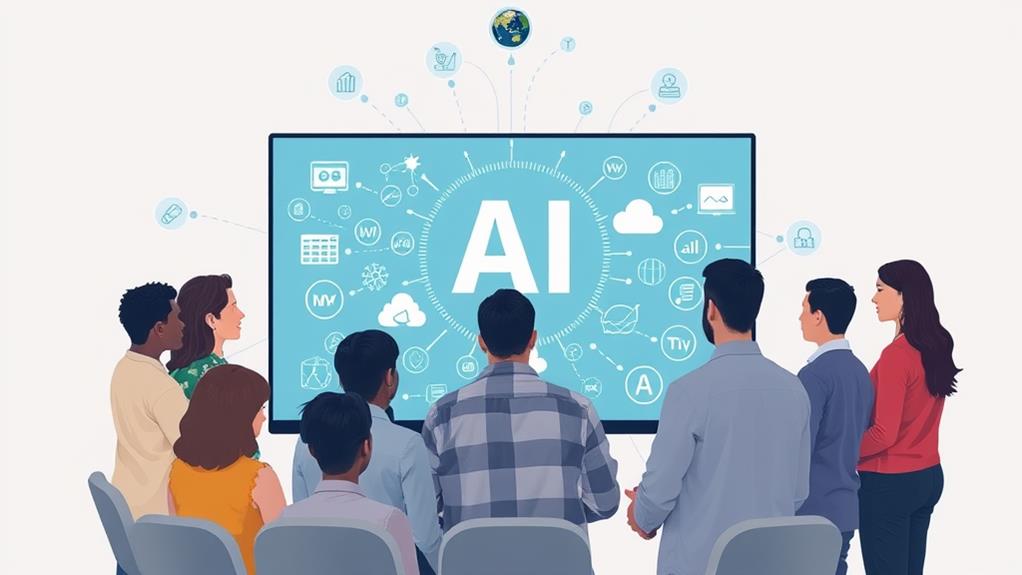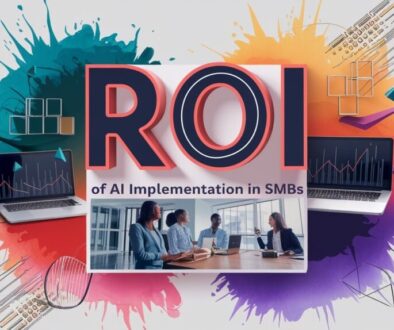How to Train Your Team for AI Implementation
To train your team for AI implementation, start by establishing a strong foundation in AI fundamentals, including its core concepts and real-world applications. Conduct skill assessments to identify gaps and align training objectives with organizational goals using the SMART criteria. Develop a structured training plan incorporating various methods like hands-on workshops and collaborative sessions. Encourage continuous learning through mentorship and regular updates on AI advancements. Finally, measure the effectiveness of training through feedback mechanisms and performance metrics. By strategically addressing these areas, your team will be better equipped to navigate AI challenges and opportunities that lie ahead.
Key Takeaways
- Begin with understanding AI basics, including machine learning concepts and real-world applications, to establish a solid foundation for your team.
- Conduct skill assessments to identify existing competencies and skill gaps within the team for targeted training efforts.
- Set clear, SMART objectives for training that align individual learning with organizational goals and commit to regular review and adjustment.
- Choose diverse training formats, such as online courses and interactive webinars, to cater to different learning styles and optimize engagement.
- Incorporate hands-on learning through practical workshops and real-world simulations to solidify knowledge and enhance problem-solving skills.
Understanding AI Basics

To effectively lead a team in AI implementation, it is essential first to establish a solid foundation in the basics of artificial intelligence. Understanding AI fundamentals is vital, as this knowledge empowers team members to grasp the underlying mechanisms driving AI technologies. AI can be broadly categorized into various domains, with machine learning emerging as a key component. This process involves training algorithms to recognize patterns and make data-driven predictions or decisions, which greatly enhances operational efficiency across various applications.
An effective training approach should begin with a clear explanation of what AI entails, including its potential to transform industries and enhance human capabilities. By emphasizing core concepts such as supervised learning, unsupervised learning, and reinforcement learning, team members can cultivate a thorough understanding of how machine learning functions and its practical implications. This foundational knowledge fosters an environment where individuals feel encouraged to explore and innovate, ultimately leading to a more engaged and motivated team.
Additionally, discussing real-world AI applications tailored to the team's industry can further solidify this knowledge. For example, exploring how businesses utilize machine learning for predictive analytics or customer personalization can inspire team members to envision AI's transformative potential within their own roles.
Through a well-structured educational strategy, organizations can nurture a culture of continuous learning and adaptability, essential traits for successful AI implementation. In this era of rapid technological advancement, embracing these AI fundamentals will empower teams to harness the full potential of artificial intelligence.
Identifying Skill Gaps
Identifying skill gaps within a team is a crucial step in the AI implementation process, as it allows leaders to pinpoint specific areas where additional training or resources are needed. Conducting a thorough skill assessment involves evaluating current team competencies against the role specifications required for successful AI integration. This meticulous approach not only enhances team dynamics but also fosters a culture of continuous learning.
To effectively implement a skill gap analysis, organizations can utilize knowledge mapping techniques to visualize existing proficiency levels in relation to technology trends in the AI landscape. Such clarity aids in the identification of essential skills that may be lacking. Moreover, aligning performance metrics with desired outcomes helps to clarify expectations for each team member, thereby informing targeted development strategies.
Addressing diverse learning styles within the team is critical for optimizing training efforts. Tailoring resources and engagement strategies based on individual preferences guarantees that training is effective and well-received. This customization fosters an environment where team members feel empowered to learn and grow, ultimately driving collective success.
Leadership involvement plays a significant role in this process, as supportive leaders can facilitate resource allocation and motivate team members to embrace continuous improvement.
Setting Training Objectives

Setting clear training objectives is essential for guaranteeing that team members acquire the necessary skills for effective AI implementation. Establishing these objectives lays a foundation for a focused training approach, enabling teams to respond proactively to the evolving landscape of artificial intelligence.
Begin by conducting a thorough analysis of current abilities and identified skill gaps, aligning training outcomes with organizational goals.
Effective training objectives must reflect goal alignment between individual learning and broader business objectives. This synergy not only fosters motivation among team members but also enhances the relevance of the training content. Each objective should be Specific, Measurable, Achievable, Relevant, and Time-bound (SMART), creating a roadmap that guides learners towards both professional growth and organizational success.
Incorporating performance metrics into training objectives is equally critical. These metrics act as benchmarks to gauge the effectiveness of the training and its impact on the team's capability to execute AI-driven initiatives. Consider developing indicators such as competency assessments, project completion rates, or team feedback to quantify progress.
Furthermore, revisiting and refining these objectives periodically ensures they remain aligned with the team's evolving needs and the dynamic nature of AI technology. This commitment to continuous improvement empowers team members to embrace their training journeys freely, cultivating a culture of innovation and adaptability that drives successful AI implementation.
Developing a Training Plan
How can organizations effectively structure their training plans to guarantee successful AI implementation? Developing a well-rounded training plan is essential for fostering team dynamics that encourage collaboration and innovation. A strategic approach involves several key elements:
- Assessment Tools: Evaluate current skill levels and identify gaps.
- Training Resources: Curate materials that resonate with diverse learning styles.
- Communication Strategies: Foster open channels to facilitate dialogue and concerns.
- Engagement Techniques: Utilize interactive methods to maintain motivation.
- Feedback Loops: Implement mechanisms for continuous improvement through regular check-ins.
When designing the training plan, it's important to differentiate content curation based on the varying expertise within the team. This guarantees that every team member can engage with the material relevant to their current abilities and aspirations.
Furthermore, integrating engagement techniques, such as gamification or collaborative projects, can enhance motivation and knowledge retention. By aligning the various components of the training plan with the learning styles of individuals, organizations can cultivate an inclusive environment.
Effective communication strategies are crucial throughout the training process. Establishing feedback loops allows for immediate adjustments to the plan, encouraging a culture of adaptability and responsiveness.
Ultimately, a thorough training plan should be an evolving document, continually refined through team feedback and tailored to the organization's specific objectives. By investing time in this process, companies position themselves for a successful AI implementation that empowers their workforce and drives innovation.
Choosing the Right Training Methods

Selecting the right training methods requires a thorough assessment of your team's skill levels to identify gaps and training needs.
It is crucial to choose formats that align with these needs while considering various learning styles to maximize engagement and retention.
Assess Team Skill Levels
Evaluating the skill levels of your team is essential for the successful implementation of AI technologies. Conducting a thorough skill evaluation not only highlights team capabilities but also pinpoints areas requiring development.
This understanding enables targeted training, fostering a culture of continuous improvement.
When gauging team skills, consider the following key points:
- Technical Proficiency: Evaluate familiarity with AI tools and programming languages.
- Problem-Solving Skills: Identify the ability to tackle AI-related challenges creatively and effectively.
- Collaboration Abilities: Assess teamwork dynamics and how well team members integrate their strengths.
- Adaptability: Gauge the responsiveness of team members to evolving technologies and processes.
- Vision Understanding: Verify awareness of how AI aligns with project goals and organizational vision.
Select Appropriate Formats
The effectiveness of team training hinges on choosing suitable training methods that align with individual learning styles and project requirements. A strategic approach to this selection can enhance engagement and retention among team members.
Online courses offer flexibility and can be designed to cater to diverse knowledge levels. Coupling these with interactive webinars promotes real-time knowledge sharing, allowing participants to engage directly with experts. Learning modules can be tailored to specific skills, supplementing other training methods seamlessly.
Incorporating team challenges fosters collaboration and practical application of learned concepts, encouraging innovation. Supplementing this with expert panels provides insights from experienced professionals, enriching the training experience.
Utilizing case studies enables members to analyze real-world scenarios, while video tutorials can break down complex topics into digestible segments.
Mentorship programs are invaluable for personalized guidance, further enhancing the learning process. Finally, establishing resource libraries guarantees that all team members have ongoing access to materials and references, promoting continuous learning.
Measure Training Effectiveness
Evaluating the effectiveness of training methods is essential to ascertain that team members are acquiring the necessary skills and knowledge for successful AI implementation.
A systematic approach not only guarantees knowledge transfer but also promotes behavioral changes that align with organizational goals.
To measure training effectiveness, consider the following strategies:
- Feedback Mechanisms: Establish channels for participants to share insights and experiences post-training.
- Performance Metrics: Identify key performance indicators that reflect improved outcomes related to AI tasks.
- Post Training Assessments: Conduct evaluations to gauge retention of knowledge and understanding of AI concepts.
- Employee Engagement: Foster a supportive environment that encourages team members to apply new skills actively.
- Skill Application: Monitor how effectively team members integrate learned skills into their daily activities.
Incorporating Hands-On Learning
Incorporating hands-on learning is essential for effective AI training, as it enables teams to engage directly with the technology.
Practical AI workshops provide immersive experiences, while real-world scenario simulations help in contextualizing theoretical knowledge.
Additionally, collaborative learning sessions foster team synergy, encouraging the sharing of diverse perspectives and problem-solving techniques.
Practical AI Workshops
To effectively equip your team for AI implementation, practical AI workshops must blend theoretical knowledge with hands-on learning experiences. These workshops should emphasize participant engagement and facilitate the application of concepts through structured interactive activities.
Offering diverse workshop formats can keep the sessions dynamic and foster an enjoyable learning atmosphere.
Consider incorporating the following elements into your workshops:
- Expert Speakers: Invite professionals from the AI field to share insights and trends.
- Case Studies: Analyze real-world applications of AI to ground learning in reality.
- Team Building Exercises: Foster collaboration while tackling AI-related challenges.
- Feedback Sessions: Enable open dialogue for participants to share their thoughts and questions.
- Technology Integration: Use current tools to familiarize teams with essential AI technologies.
Real-World Scenario Simulations
By engaging in real-world scenario simulations, teams can bridge the gap between theory and practice in AI implementation. These simulations promote scenario development that encourages effective role playing, enabling team members to immerse themselves in complex problem-solving situations. Participants can explore decision making processes, evaluate different strategies, and actively engage with the implications of their choices in the context of AI applications.
Incorporating feedback loops into these simulations enhances team dynamics by allowing individuals to reflect on their interactions and decisions collaboratively. This approach aids in refining risk assessment skills and facilitates an understanding of user experience by placing team members in the shoes of end-users during the scenario.
Additionally, real-world simulations provide opportunities for data interpretation, where participants analyze performance metrics to gauge the success of their strategies. By dealing with realistic scenarios, teams gain a deeper understanding of potential challenges and develop the agility needed to navigate the complexities of AI implementation.
Ultimately, these hands-on learning experiences empower team members to think critically and adapt effectively, promoting a culture of continuous improvement and innovation within the organization.
Collaborative Learning Sessions
Following the practice of real-world scenario simulations, collaborative learning sessions serve as another effective method for fostering team engagement and skill development in AI implementation.
These sessions encourage an environment where team members can share knowledge, challenge ideas, and cultivate innovative solutions through hands-on experience.
Key benefits of collaborative learning sessions include:
- Enhanced Knowledge Sharing: Team members pool their unique insights and expertise, enriching the learning experience for all.
- Peer Feedback: Constructive feedback from peers promotes continuous improvement and elevates individual contributions.
- Improved Problem-Solving Skills: Collaborative efforts enable teams to tackle complex AI challenges collectively.
- Increased Engagement: Participants are more invested in a learning environment that values their input and creativity.
- Stronger Team Dynamics: Working together fosters relationships and builds trust among team members.
Promoting Continuous Learning

In the swiftly changing landscape of artificial intelligence, fostering a culture of continuous learning is vital for teams aiming to stay competitive and innovative. This culture thrives on proactive knowledge sharing, where team members are encouraged to exchange insights and experiences.
Implementing mentorship programs can enhance this dynamic, allowing seasoned professionals to guide newer team members, thereby accelerating their learning curve.
To promote an innovation culture, organizations should establish structured feedback loops, enabling employees to learn from both successes and failures. Regularly scheduled technology updates are significant, as they allow teams to engage with the latest advancements in AI and adjust their practices accordingly.
Providing diverse learning resources—such as online courses, webinars, and relevant literature—ensures that team members have access to the tools necessary for their growth.
Cross-training initiatives can further enrich this ongoing learning environment by exposing employees to different roles and functions within the organization. This approach not only broadens their skill sets but also fosters a collaborative spirit.
Additionally, informal learning opportunities, such as lunch-and-learn sessions or discussion groups, create a relaxed space for team members to explore new ideas together.
Measuring Training Effectiveness
As teams embrace continuous learning within the domain of AI, it becomes essential to establish effective metrics for measuring training effectiveness. Understanding how well your training initiatives resonate can illuminate areas for improvement and guarantee the knowledge gained translates into performance gains.
To measure training effectiveness, consider implementing the following strategies:
- Feedback Mechanisms: Encourage real-time feedback during sessions to adapt training dynamically.
- Performance Metrics: Establish clear KPIs that align with organizational goals and evaluate learners' application of new skills in relevant tasks.
- Training Surveys: Utilize pre- and post-training surveys to gauge learners' perspectives on the training content and delivery.
- Skill Assessments: Conduct assessments before and after training to measure knowledge retention and proficiency in AI-related skills.
- Engagement Levels: Track participants' engagement during sessions through participation rates and interactions.
Post-training evaluations are crucial for analyzing learning outcomes. These evaluations should focus not only on immediate knowledge retention but also on long-term skill application and job performance enhancements.
Addressing Ethical Considerations

Ethically addressing the implications of AI implementation is a crucial step that organizations must consistently prioritize. The integration of AI technologies carries significant moral implications, impacting not just internal operations but the broader society. Establishing ethical frameworks is fundamental to guide decision-making throughout the lifecycle of AI deployment.
Central to these ethical considerations is bias mitigation. Organizations should implement rigorous fairness assessments during the development and testing of AI systems to identify and rectify potential biases. Transparency practices further enhance accountability; stakeholders must understand how AI systems operate and make decisions.
By engaging in stakeholder involvement, organizations can gather diverse perspectives that contribute to a more balanced approach to AI integration. Data privacy is another critical focus area. It is essential for organizations to develop robust practices that safeguard personal information and comply with regulatory compliance standards. This not only protects individuals but also builds trust within the community.
Furthermore, accountability measures must be established to guarantee that the deployment of AI technologies does not inadvertently lead to harmful societal impacts. This includes setting up mechanisms for addressing grievances and accountability solutions when ethical breaches occur.
Frequently Asked Questions
How Do We Secure Buy-In From Management for AI Training Initiatives?
Securing buy-in from management for training initiatives requires a strategic approach to change management and leadership engagement.
Clearly articulate the benefits of AI training, highlighting expected improvements in efficiency and innovation.
Facilitate open communication, allowing leaders to express concerns and provide input.
Collaboratively develop a thorough training plan that aligns with organizational goals.
What Budget Considerations Should We Keep in Mind for Training?
When considering budget allocations for training, it is essential to account for training costs, which encompass both direct expenses and potential resource allocation shifts.
Prioritize team readiness by investing in extensive programs that foster skill development and adaptability. Emphasizing this as a long-term investment will underscore its value to stakeholders, ensuring a robust framework for growth.
A strategic approach will enable seamless integration and maximize the return on investment in workforce capabilities.
How Can We Balance AI Training With Ongoing Project Demands?
Balancing AI training with ongoing project demands necessitates effective time management and a thorough skill assessment.
Prioritize training modules that align with current project goals, and integrate learning into existing workflows to minimize disruption.
Designate specific times for education that accommodate team schedules, ensuring flexibility.
Regularly assess team skills to tailor training, fostering a culture of continuous improvement that empowers employees while maintaining productivity in their existing roles.
Should We Bring in External Consultants for AI Training?
Bringing in external consultants for training can greatly enhance training effectiveness. Their external expertise can provide fresh perspectives, guarantee that the latest advancements in AI are addressed, and facilitate knowledge transfer without disrupting ongoing projects.
Balancing the depth of training with project demands requires strategic planning, yet the infusion of specialized insight can ultimately foster a culture of innovation and adaptability. This approach empowers teams, aligning their skills with evolving industry standards.
How Do We Keep Team Morale High During the Training Process?
Maintaining high team morale during training is essential for successful outcomes. Implementing effective team engagement strategies, such as recognizing individual contributions and fostering open communication, cultivates a positive atmosphere.
Additionally, scheduling continuous feedback sessions encourages team members to express concerns and share insights, reinforcing a sense of ownership in the training process.
Conclusion
To summarize, the successful implementation of AI within a team requires a strategic approach to training that encompasses foundational knowledge, skill identification, and continuous growth. Just as a sculptor chisels away at marble to reveal a masterpiece, organizations must diligently refine their workforce's capabilities, ensuring alignment with the evolving demands of technology. By fostering an environment of learning and ethical awareness, teams can navigate the complexities of AI, ultimately transforming potential challenges into opportunities for innovation.




